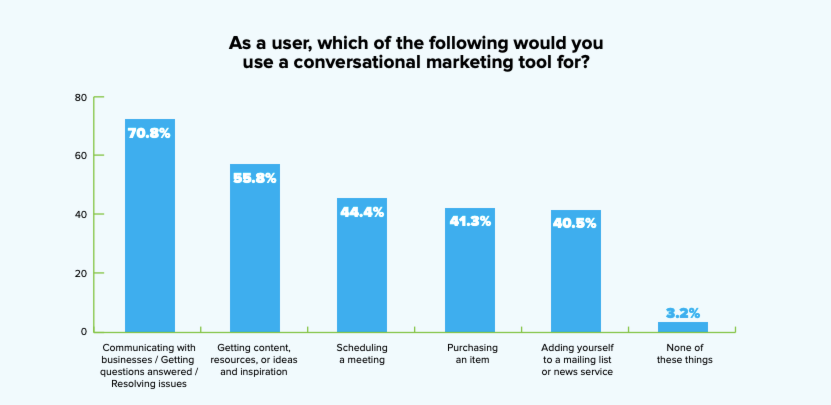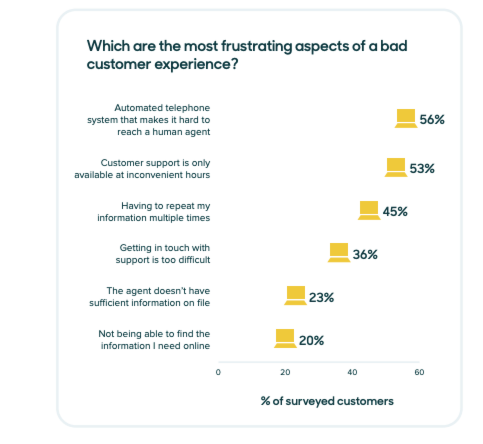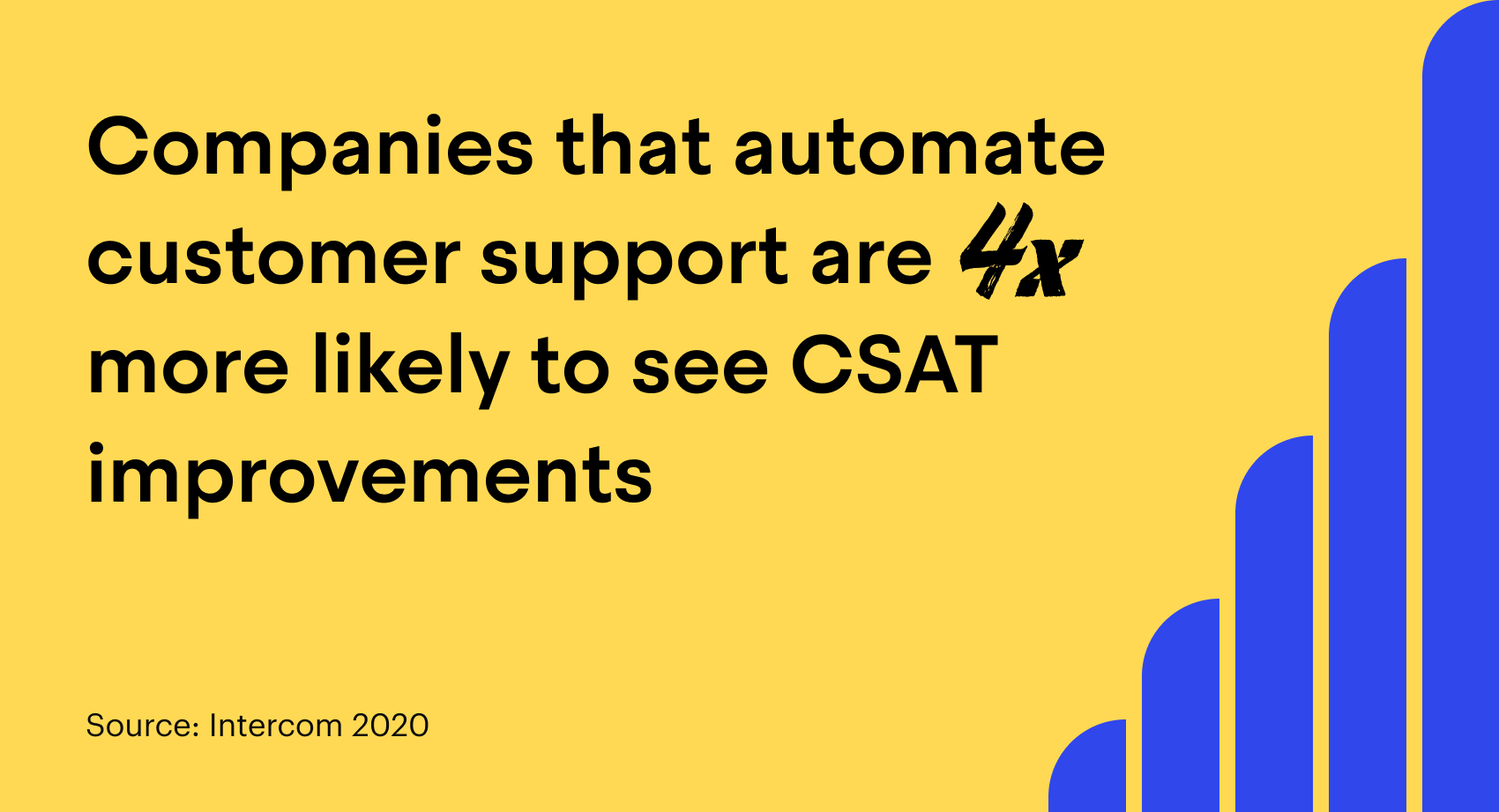How to choose the best live chat software in 2021
Live chat gives your customers answers in real-time as they’re browsing. Not all options are created equal, though.
Live chat gives your customers answers in real-time as they’re browsing. Not all options are created equal, though.
Customers want fast answers as they’re browsing your website. Need a reliable way to deliver speedy responses? Then you need live chat.
Not all software is created equal, though.
Before you choose a live chat tool, you need to understand the tools in the market, so you can choose the best live chat software for your business goals.
Table of Contents
Live chat software empowers you to respond to customers quickly with their account details at your fingertips.
If your agents respond quickly, website visitors are more likely to make a purchase. They’re already on your website and interested in your product. Live chat eliminates the back and forth of email that could take days, at which point they may have lost interest.
While phone calls offer real-time service, live chat is still faster. With live chat, agents can have multiple conversations at once, so they can continue helping other customers while waiting for a reply. You’ll help more people and get more out of your agents’ salaries with the saved time.
Live chat encourages customers to convert. They get the answers they’re looking for without leaving your website. You can support your customers’ purchase journey by answering their questions while they’re browsing.
Forty-one percent of consumers report using live chat to make a purchase, which more than doubled from 2019 at 17%, according to Drift.

Because customers aren’t leaving your website, their excitement won’t dwindle while they’re waiting for an email response.
Customers want to be understood. According to Zendesk, 45% of customers reported that repeating themselves is the most frustrating aspect of a customer service experience.

Depending on the software you choose, live chat software can tell you a visitor’s browsing history, referring URL, previous conversations, and purchase history. You can offer the right solution without having to ask a lot of questions.
A customer data platform, like Segment, will provide even more context to your conversations. Segment sits between other data sources — like your website, Shopify, CRM, and data warehouses — and your live chat software. It funnels your data into your live chat software so that you can personalize every interaction.
If you opt for live chat software with a chatbot, you’ll benefit from choosing a software that can field common questions before involving an agent. Your chatbot can answer common questions like “Where do you ship?” or “How do I update my account information?” Then, if an agent is needed, the chatbot can add an agent to the chat. Choosing software with these features will reduce your agents’ workload and free them up to answer more complex questions (and according to Intercom's latest report, will increase CSAT scores in doing so.)

Live chat gives you additional information that can be used by multiple teams. Beyond chat history, live chat software can provide you with information on browsing history, referring URLs, conversion rates, and more. You can also use conversation tags to see how different types of conversations or customer questions impact revenue.
Your customer support team can use this data to improve help docs, chatbots, and customer interactions. Your marketing and sales teams will be able to identify trends in behavioral data to improve on-page content, ads, and email marketing strategies. The product team can diagnose common pain points to add or change product features.
The best live chat software will be different for every business, and each tool has different strengths. Keep these factors top of mind when evaluating the best live chat software to help you reach your business goals.
Your intended use case will affect what live chat features and integrations you need. If you need live chat for customer support, the software should connect to your help docs—which will often be a part of your primary help desk software like Help Scout or Zendesk. It should also show a customer’s purchase history for context – e.g., through a Shopify integration for e-commerce stores. This way, your support team can answer questions specific to the customer’s account.
Live chat software for sales should connect to your CRM. Chatbots that are optimized for sales typically have features that guide customers toward conversions. The best chatbots for sales will use behavioral insights to initiate a conversation at the right time, offering a demo or guiding the customer toward the pricing page.
If your live chat software is difficult for your support agents to use, it might hinder their performance. You don’t want software that would make it hard to distinguish between customers if you have multiple chat windows open. Live chat software should make it easy to manage multiple customers at the same time.
It should also empower your agents to help customers effectively with template responses, have the ability to assign a conversation to the appropriate agent, and organizational features like conversation tags.
Chatbots save support and sales teams time by screening for common questions and aid in lead qualification. For support, chatbots can utilize help docs and logic-based rules defined by your team to answer questions that don’t require a live agent. Questions like “What’s your pricing?” and “How do I integrate with Dropbox?” can be answered without taking up your agents’ valuable time. Chatbots for sales can aid in lead generation by gathering information like email addresses, product interest, and intended use case.
Choose a live chat software that makes sense based on your company’s size. A tool that doesn’t offer organization and collaboration functionality, for example, might not be compatible with large organizations. On the other hand, a tool that’s especially costly and feature-heavy likely won’t be a good fit for a new, small company.
Find the tool that supports your current team now, as well as how you might scale in the foreseeable future.
If your live chat software integrates with your customer service or sales setup (like your help desk and CRM), you’ll be able to see all of a customer’s interactions across channels to provide context for the conversation.
Additional integrations can connect to e-commerce stores, analytics platforms, and more, so you can get the most out of your live chat solution.
Now that you know what you’re looking for in a live chat solution, it’s time to consider your options. Here are some of the best live chat tools on the market. If you use Segment, you’re in luck.
All these options integrate with Segment, so you can use data from live chat across the organization.
Zendesk Chat is part of a larger ecosystem of sales and customer support software by Zendesk, though you can also sign up for the live chat software separately. With enterprise-level features—like roles and permissions and skills-based routing — Zendesk Chat can scale with your business.
Top features:
Reach out to customers automatically with targeted messages based on their behavior.
Share files with your customers directly in chat.
Field common questions, gather relevant information, and connect customers with the right agent using AI-powered chatbots.
Track conversions to see how live chat is making an impact on your objectives.
Ideal for:
Company size: Small to enterprise
Department: Support or sales
Company type: E-commerce or SaaS
Help Scout’s live chat tool is integrated as part of their full customer service platform. It has a unique Happiness metric to gear support teams toward customer satisfaction as opposed to tickets solved. Help Scout manages customer expectations by hiding the chat window on users’ screens if there are no agents online.
Top features:
Create help docs that customers can use to find the answers they’re looking for before talking to an agent.
Offer recommended articles to customers based on the page they’re on.
Integrate with dozens of apps to see a customer’s history alongside your conversations with them.
Ideal for:
Company size: Small
Department: Support
Company type: E-commerce or SaaS
Intercom offers three distinct solutions (marketing, customer engagement, and support) that use live chat as an integral part of the customer journey. Intercom is designed to integrate with customer data platforms, like Segment, so you can view customer data and personalize conversations as you’re chatting.
Top features:
Use conversational chatbots to qualify leads, give product tours, and automate meeting bookings.
Segment customers to personalize outreach.
Optimize performance with A/B testing and message versioning.
Ideal for:
Company size: Small to enterprise
Department: Support or sales
Company type: SaaS
GoSquared Live Chat is part of a complete growth suite for SaaS companies. While you can use Live Chat on its own, the full suite includes analytics and marketing automation features. The Live Chat product provides context for your chat conversation and uses behavior-based automations to encourage conversions.
Top features:
Engage with visitors automatically based on their behavior.
Build customer profiles with contextual information to have tailored conversations.
Use in-app messages for onboarding new customers with the right message at the right time.
Ideal for:
Company size: Small
Department: Sales
Company type: SaaS
Drift is another sales-focused live chat software that’s ideal for SaaS companies. The chatbot personalizes engagement with customers and even schedules meetings with qualified leads. Drift’s free plan offers a simple live chat option, so you can test out the platform before committing.
Top features:
Start conversations with the most engaged customers as prioritized by Drift’s powerful API.
Book meetings automatically with the right sales agent, even if they’re offline.
Integrate with your sales and marketing platforms for extra context for your conversations.
Ideal for:
Company size: Small to enterprise
Department: Sales
Company type: SaaS
Olark is a dedicated live chat solution ideal for small businesses. Have access to chat transcripts and notes in your email interactions with help desk and CRM integrations. E-commerce stores can use the CartSaver feature to see what’s in a customer’s shopping cart during the chat.
Top features:
Integrate with Google Analytics to see how many sales result from a chat.
Send automatic messages based on location, referring URL, and browsing behavior.
Monitor friendliness, knowledgeability, responsiveness, and chat experience with customer feedback.
Ideal for:
Company size: Small
Department: Sales and support
Company type: E-commerce or SaaS
LiveChat is an omnichannel customer service platform for sales and proactive customer service. Its robust features—like the ability to send and receive files or book a demo right in chat—make engaging and converting customers easy.
Top features:
See what a customer is typing before they hit enter, so you can respond faster.
Segment customers to target hot leads.
Calculate chat ROI and see which agents are most effective at converting customers.
Ideal for:
Company size: Small to enterprise
Department: Support or sales
Company type: E-commerce or SaaS
SnapEngage is a dedicated live chat software that can sync with your CRM or help desk. Start a live chat proactively based on behavior, or set up the chatbot to speak with customers when an agent isn’t available. Reporting features track performance and offer insights into how leads found you.
Top features:
Customize workflows to target, qualify, and convert leads with proactive messaging.
Manage all your chat interactions from one place with integrations for SMS, social media, and mobile apps.
Optimize the workload by using analytics to figure out how many chat agents you need working and when.
Ideal for:
Company size: Small to enterprise
Department: Support or sales
Company type: E-commerce or SaaS
Gist is an all-in-one customer experience platform that includes live chat, email marketing, and a knowledge base. By centralizing customer communication between support, sales, and marketing teams, you can send conversations to the right team and collaborate across departments.
Top features:
Initiate conversations based on behavior with customizable automatic messages.
View which customers are on your website now and initiate live conversations.
Generate and qualify leads with the chatbot, and book sales meetings.
Ideal for:
Company size: Small to mid-market
Department: Support or sales
Type: E-commerce or SaaS
Richpanel is an ideal helpdesk solution for e-commerce stores. It automates returns and allows you to track orders and make changes to orders. These features can help reduce any e-commerce store’s support load. Plus, you can manage all your support channels in one place.
Top features:
Automate standard e-commerce functions like returns, order tracking, and order editing.
See customer history, including orders, browsing activity, and previous communications while chatting.
Collect important data and route the conversation to the appropriate agent automatically.
Ideal for:
Company size: Small to mid-market
Department: Support
Type: E-commerce
Before you choose a live chat solution, make sure you have the bandwidth to introduce it as an integral part of your strategy.
Customers expect a quick response. In fact, 43% of consumers expect a response time of 5 seconds or less. If you can’t meet customer expectations, you won’t reap the benefits of live chat and might even sour the customer relationship. Be sure you have enough staff coverage to engage with customers in real-time.
To get the most out of live chat, you should also have the bandwidth to analyze live chat data to continually improve the user experience. Then, integrate learnings from live chat across the organization.
New to Segment?
Segment is the industry-leading customer data platform to collect, standardize, and forward data to 400+ marketing and business analytics tools. It sits between data sources and destinations to make customer insights accessible across the business.
Sign up for a demo to learn how Segment can help you better understand your customers and engage with them effectively.

Our annual look at how attitudes, preferences, and experiences with personalization have evolved over the past year.